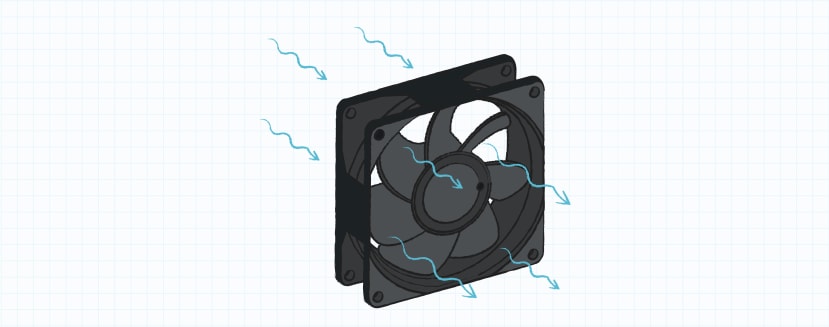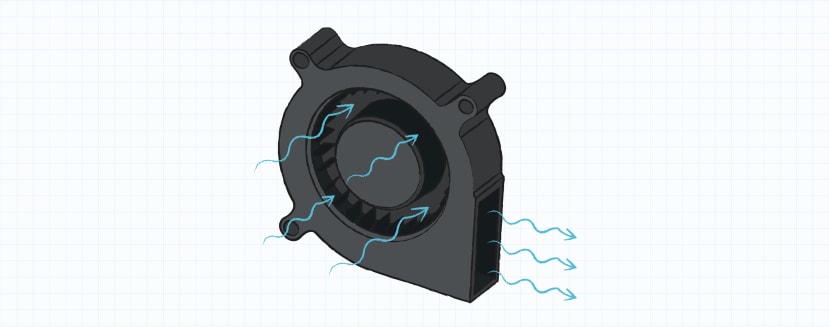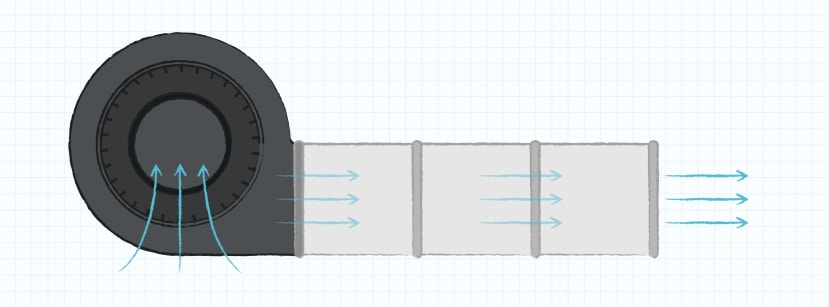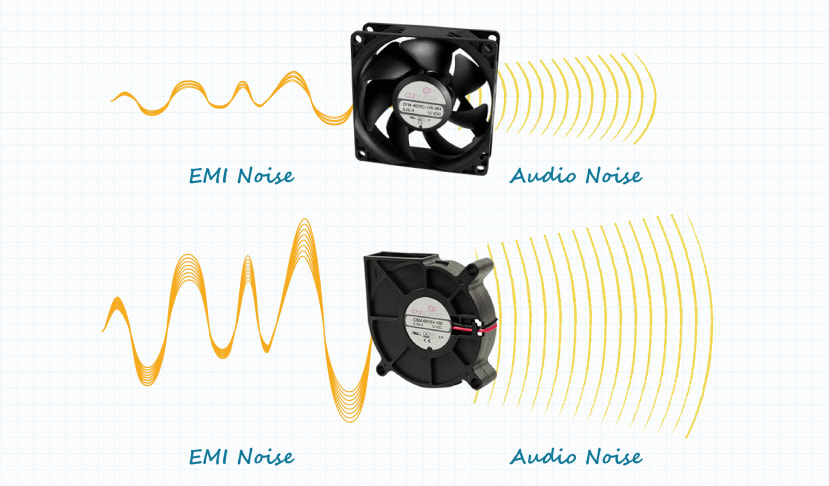Axial or Centrifugal Fans – Which is Best for Your Design?
Follow articleHow do you feel about this article? Help us to provide better content for you.
Thank you! Your feedback has been received.
There was a problem submitting your feedback, please try again later.
What do you think of this article?
Any component or system which dissipates power will generate heat that can have adverse effects on its performance. Therefore, thermal management is a critical aspect of engineering design.
The fundamental engineering principle to address thermal management is to cool the component or system by transferring heat away. This can be achieved by means such as throttling the power in the system, applying heat sinks or using pipes or cold plates to enhance heat dissipation. In many practical applications, however, cooling can be achieved by using a fan to move air over the hot component.
Choosing the right type of fan is important for optimal thermal management, and there are two primary options to consider: an axial fan or a centrifugal fan. Each type operates on different principles, and their design has unique advantages and disadvantages. As such, it is crucial to consider their characteristics and applications when selecting the appropriate fan for a specific cooling task.
This article aims to provide an overview of the operating principles of each fan type, discuss their typical applications, and highlight the pros and cons of each design to help make an informed decision for effective thermal management.
Axial Fans Overview
Axial fans utilize a motor-driven rotating shaft (axis) that supports blades mounted at an angle (skewed) to pull air in and force it out parallel to the shaft. They are sometimes referred to as propeller fans and can be designed as tube axial or vane axial fans to fit within a duct.
Figure 1: Airflow direction of an axial fan (Image source: CUI Devices)
Axial fans are capable of moving high volumes of air effectively and efficiently, making them well-suited for cooling equipment or ventilating spaces. These fans are available in various sizes, ranging from board level to room size, and they require relatively low power to operate, depending on their size. Furthermore, they are offered in both ac and dc models. AC-powered fans typically use line current and are rated above 100 volts, while DC-powered fans can have much lower voltages (such as 3, 5, 12, 24, or 48 Vdc) and are often driven by a power supply or batteries.
Axial fans are designed to deliver large volumes of air at low pressure. This unique combination of low pressure and high airflow makes them ideal for cooling equipment or ventilating large spaces evenly. Axial fans are widely used in various applications, such as cooling electronic equipment, computer rooms, and server racks. They can also be used in HVAC operations, ac condensers, heat exchange units, or for spot cooling in industrial systems. Additionally, axial fans can function as exhaust fans, effectively extracting air from an enclosed space.
Overall, axial fans are well-suited for applications that require high volumes of airflow at low pressure and are versatile enough to fit a range of cooling or ventilation needs.
Centrifugal Fans Overview
Centrifugal fans, also known as radial fans or blowers, employ a motor-driven hub that contains impellers, which project air into the fan housing and then redirect it through an outlet. Unlike axial fans, centrifugal fans discharge air at a perpendicular, 90-degree angle to the air intake.
Figure 2: Airflow direction of a centrifugal fan (Image source: CUI Devices)
These fans generate a steady, high-pressure stream of air with lower volumes than axial fans. Depending on the application, they come with either forward or backward-curved impellers for either blowing or suction. Centrifugal fans can pressurize air within the blower housing, allowing them to target specific areas for cooling, making them ideal for dissipating heat from individual parts of an electronics system that generate high amounts of heat, such as power FETs, DSPs, or FPGAs.
Like axial fans, centrifugal blowers are also available in both AC and DC powered models. However, they generally require more power to operate than axial fans and produce more audible and electromagnetic noise. The enclosures surrounding the moving parts in their design make them reliable, durable, and difficult to damage.
Centrifugal fans are useful for moving air through a concentrated area, such as ductwork or pipes, or for exhaust or ventilation uses. They operate well in harsh and dirty environments with particulates, hot air, and gasses, making them well-suited for applications in air conditioning or drying systems. In electronics, centrifugal fans are commonly found in small devices like laptops, where the air is expelled at a 90-degree angle from the intake for higher directionality.
Figure 3: Centrifugal fan in a duct application (Image source: CUI Devices)
Fan EMI and Noise
When designing a system that incorporates fans, it is important to consider the potential for electromagnetic interference (EMI) and audible noise. All fans have the potential to generate radiated EMI from the fan itself or conducted EMI from the power leads. Uncontained magnetic fields (UMF) can also contribute to EMI, which arise from motor magnets or stator windings. Early consideration of these factors can save time and money in the long run, particularly in applications that are sensitive to EMI.
Figure 4: Comparing EMI and audio noise in axial and centrifugal fans (Image source: CUI Devices)
DC-powered fans tend to produce less EMI than AC-powered fans, and the audible noise generated by fans can also vary widely depending on factors such as application, placement, and size. Bearing types used in fans can also affect acoustics and lifespan. A good rule of thumb is that the higher the airflow (or CFM) the higher the noise. However, larger fans are generally quieter when moving the same amount of air as a smaller fan. Mechanical isolation, air inlet grills, and outlet diffusers can also help mitigate audible noise. Axial fans typically produce less noise than centrifugal fans.
Final Breakdown
To help recap, here is a quick comparison of the various pros, cons, and characteristics of axial and centrifugal fans. The best option will ultimately depend on the intended application, available space, and overall thermal requirements of the end system.
Table 1: Final comparison of axial and centrifugal fans (Image source: CUI Devices)
Conclusion
Effective convective cooling is essential for managing unwanted heat generated by electrical equipment, and both axial fans and centrifugal fans have demonstrated their effectiveness through years of field use and ongoing technological advancement. These fans now utilize stronger, lighter, and more cost-efficient materials in their modern designs. Choosing between the two types will depend on the specific requirements of the system.






